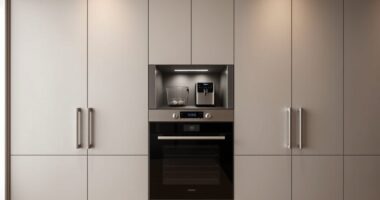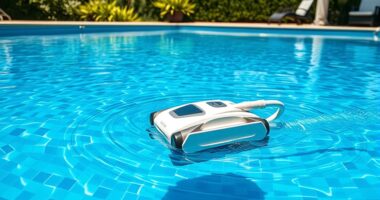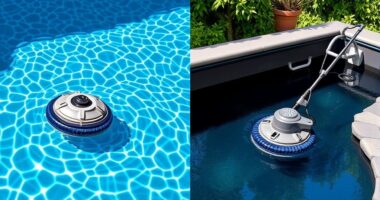Choosing the right wine fridge or cellar can perfectly match your space and style, from sleek modern units with smart technology to rustic racks with vintage charm. Consider storage capacity, environmental controls like temperature and humidity, and your home’s layout for ideal placement. Incorporate aesthetic elements like lighting and finishes to blend seamlessly with your décor. With the right setup, you’ll keep your collection pristine and stylish—exploring more can help you craft the perfect wine display.
Key Takeaways
- Choose the appropriate storage solution based on collection size, space, and aesthetic preferences, such as wine fridges, racks, or built-in cellars.
- Maintain consistent temperature around 55°F and humidity levels between 60-70% for optimal wine aging and preservation.
- Incorporate modern design features like LED lighting, smart controls, and sleek finishes to enhance style and functionality.
- Ensure proper placement in cool, dark, well-ventilated areas, avoiding sunlight and heat sources to protect wine quality.
- Use space-efficient storage options like modular racks and vertical stacking to maximize capacity and organization.
Types of Wine Storage Solutions
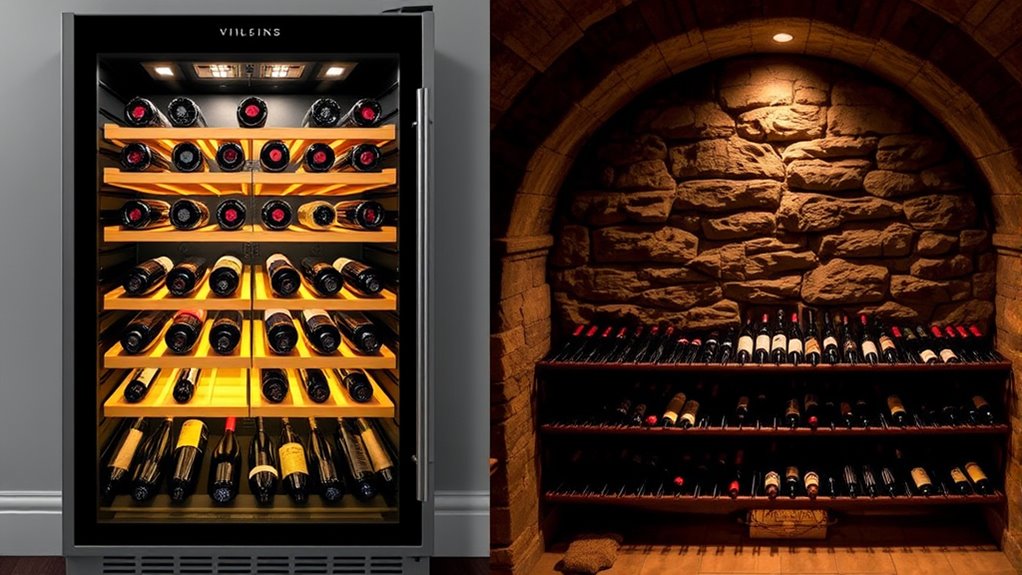
When choosing a wine storage solution, understanding the different types available can help you find the best fit for your collection. If you enjoy wine pairing, proper storage guarantees flavors mature perfectly over time. Traditional wine cellars use natural or built-in cooling, ideal for larger collections and authentic vineyard vibes. Wine racks and cabinets offer convenient, stylish options for smaller spaces, maintaining ideal humidity and temperature. Wine fridges are versatile, energy-efficient, solutions perfect for enthusiasts who want easy access and temperature control. Some collectors even visit vineyard tours to learn about wine aging processes, which can influence their storage choices. Whether you prefer a rustic cellar or a modern fridge, selecting the right type depends on your collection size, space, and how you plan to enjoy your wines over time. Proper temperature control is essential for preserving wine quality and ensuring optimal aging conditions.
Key Factors to Consider When Choosing a Wine Fridge or Cellar
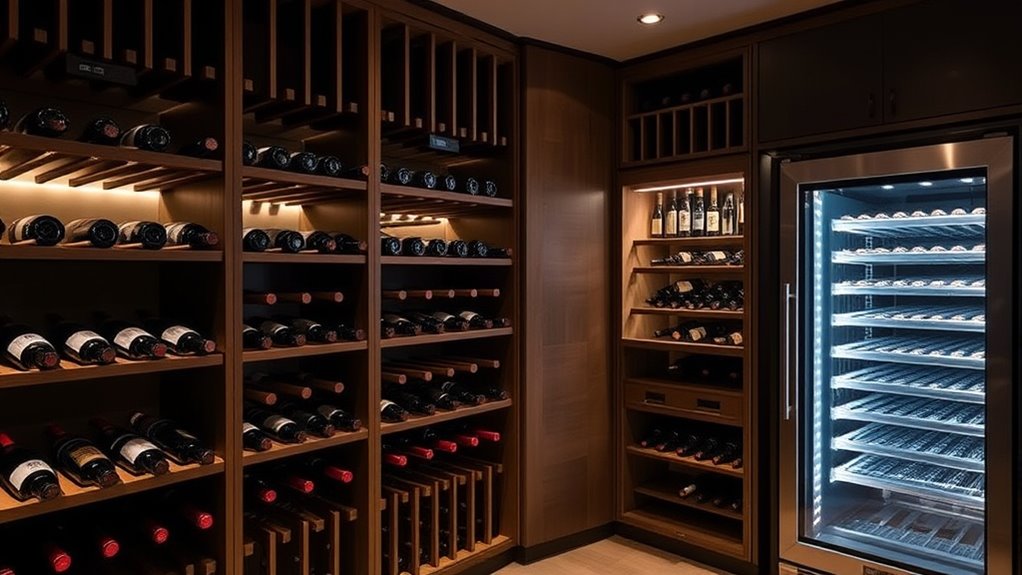
When selecting a wine fridge or cellar, you need to consider the proper temperature settings to keep your wines at their best. The size and capacity are also important, so you choose a unit that fits your collection without overcrowding. By focusing on these factors, you’ll make sure your wines stay in ideal condition. Additionally, understanding relationship dynamics can help you better manage shared spaces and ensure a harmonious environment for your collection.
Proper Temperature Settings
Choosing the right temperature setting is crucial because it directly affects the quality and aging potential of your wine. Proper wine preservation depends on maintaining a consistent temperature, which is why accurate temperature calibration is essential. Generally, reds should be stored between 55-65°F, while whites and sparkling wines prefer slightly cooler settings around 45-55°F. Fluctuations can harm your collection, so avoid settings that cause temperature swings. Many wine fridges come with adjustable thermostats to help you fine-tune the environment. Ensuring the temperature is precise not only protects your wine from spoilage but also optimizes aging. Always verify your fridge’s temperature regularly with a reliable thermometer to keep your collection in perfect condition.
Size and Capacity
How much wine you plan to store considerably influences the size and capacity of your fridge or cellar. If you mainly collect a few bottles of your favorite wine, a compact unit with space for 12 to 30 bottles might suffice. However, if you have a larger collection, you’ll need a unit with greater capacity, possibly accommodating 100 or more bottles. Consider the different wine bottle types you plan to store, such as standard Bordeaux or larger Burgundy bottles, which may affect how many fit in each storage container option. Some wine fridges and cellars offer adjustable shelves or modular storage, allowing you to customize space based on bottle sizes. Additionally, understanding zoning laws can be important if you plan to build a dedicated wine cellar at your property. Selecting the right size guarantees your collection stays organized, properly stored, and easy to access.
Design and Aesthetic Options for Wine Storage
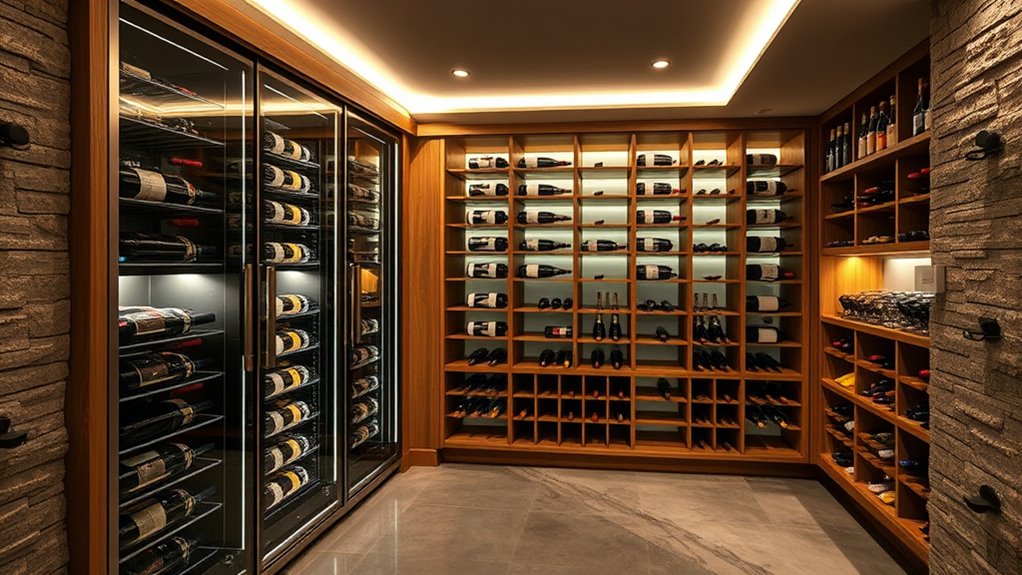
The design and aesthetic options for wine storage play a crucial role in both functionality and visual appeal. You can customize your space with various styles that match your home decor. Lighting design is key—think LED strips or subtle spotlights that highlight your collection without warming bottles. Color schemes also set the mood; neutral tones create a sleek look, while bold colors add personality. Here’s a quick overview:
| Style Type | Lighting Design | Color Schemes |
|---|---|---|
| Modern | LED strip lighting | Monochrome, metallic |
| Rustic | Warm, ambient lighting | Earth tones, wood finishes |
| Minimalist | Discreet, integrated lighting | Black & white, subtle hues |
Choose options that reflect your style and enhance your collection’s presentation. Additionally, selecting the right storage containers can help maintain optimal conditions and organize your bottles effectively.
Temperature and Humidity Control: Ensuring Optimal Conditions
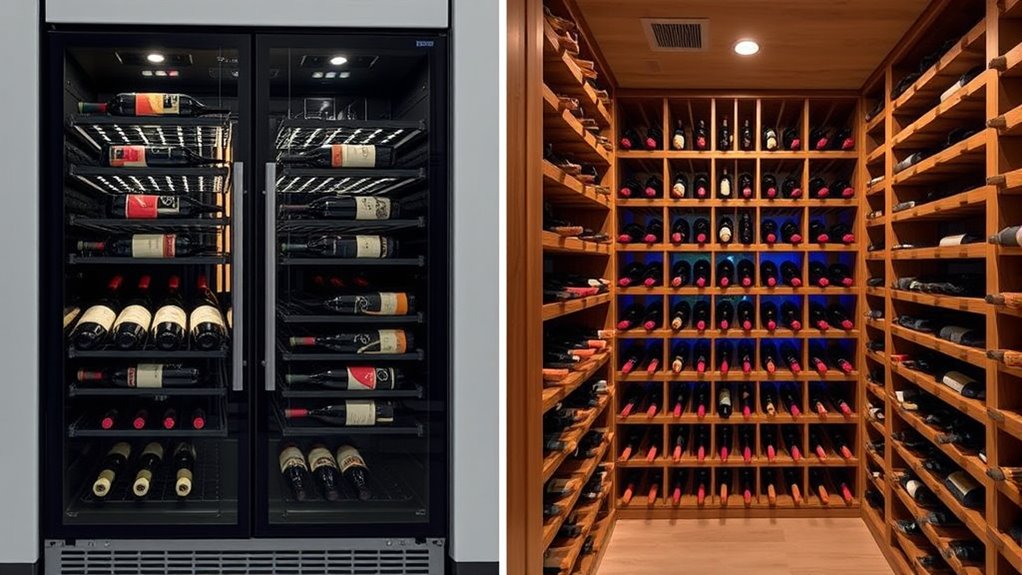
Maintaining the right temperature and humidity levels is vital for preserving your wine collection’s quality and flavor. Proper humidity regulation prevents corks from drying out or molding, ensuring a tight seal and preventing spoilage. Temperature stability is equally important; fluctuations can accelerate aging or cause undesirable changes in your wine. Invest in a wine fridge or cellar with precise controls that maintain consistent conditions, ideally around 55°F (13°C) and humidity levels between 60-70%. Regularly monitor these settings to avoid sudden shifts, which can compromise your wine’s integrity. Color accuracy in your storage environment can also influence the preservation process, ensuring your wines are kept in optimal conditions. By focusing on stable temperature and humidity, you create an ideal environment that protects your collection and enhances its aging potential. This careful control is essential for keeping your wines in top condition over time.
Space Planning and Placement Tips
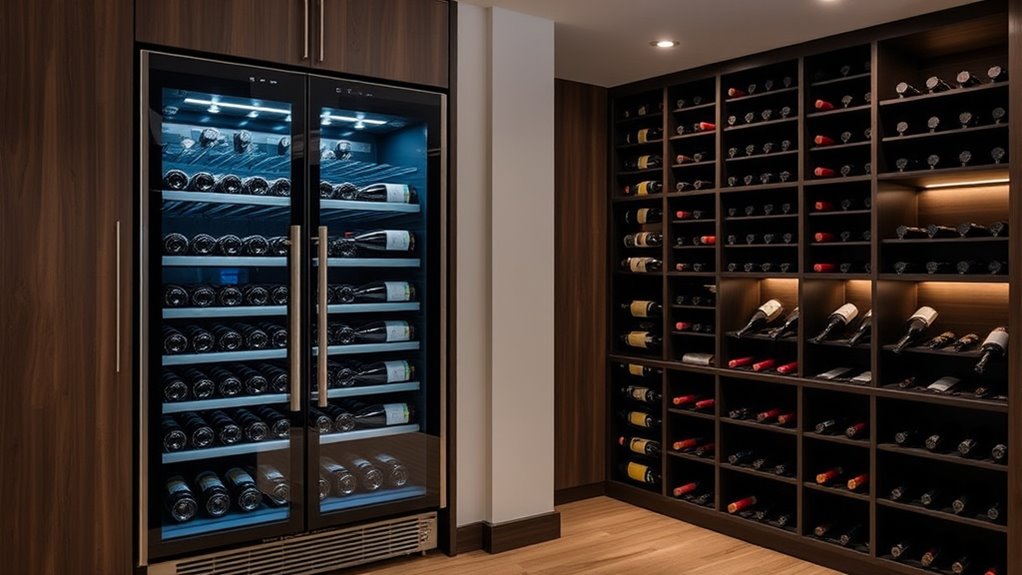
Choosing the right room is key to keeping your wine in top condition, so look for a space that stays consistently cool and dark. Make sure the area has proper ventilation to prevent heat buildup and humidity issues. Proper climate control is essential to maintain optimal storage conditions for your collection. Ultimately, plan your layout to maximize space efficiency without compromising access or airflow.
Optimal Room Selection
Selecting the right room for your wine fridge or cellar is essential for preserving your collection. Climate considerations are critical; choose a space with stable temperatures, ideally between 55-58°F, and consistent humidity levels. Avoid rooms prone to temperature fluctuations or drafts. Ambient lighting also plays a vital role—exposure to direct sunlight can damage wine, so opt for a room with minimal natural light or install blackout curtains. Keep lighting subdued and avoid harsh bulbs that emit heat. Additionally, steer clear of areas near heat sources like ovens or radiators. By prioritizing climate stability and controlling ambient lighting, you create an ideal environment that safeguards your wine’s quality and longevity. Proper room selection ensures your collection ages gracefully in perfect conditions. Ensuring proper humidity levels is also crucial, as fluctuations can negatively impact wine storage over time.
Adequate Ventilation Needs
Have you considered how proper ventilation impacts your wine storage? Adequate airflow management is essential to maintain consistent temperature and humidity levels, preventing mold and spoilage. Ventilation requirements vary depending on your space, but ensuring good air circulation is key. Proper placement of your wine fridge or cellar allows heat to escape and fresh air to circulate, protecting your collection. Additionally, integrating wall organization solutions can help optimize space and airflow around your wine storage area.
Space Efficiency Strategies
Effective space planning maximizes your wine storage while maintaining proper ventilation. To optimize space, consider stacking bottles securely in designated areas, ensuring easy access without overcrowding. Modular racks are your best tool—they adapt to your collection’s size and shape, allowing flexible configurations. Place racks vertically or horizontally to utilize corners and narrow spaces efficiently. Keep bottles in a consistent orientation to prevent damage and facilitate airflow. Avoid overstuffing your storage, which can hinder ventilation and lead to temperature fluctuations. Use tiered or stackable racks to maximize vertical space, and group wines by type or frequency of use for quick access. Properly planned placement not only saves space but also preserves your wines’ quality over time. Additionally, understanding the importance of airtight seals can help maintain consistent temperatures and prevent spoilage.
Innovative Features and Technology in Modern Wine Coolers
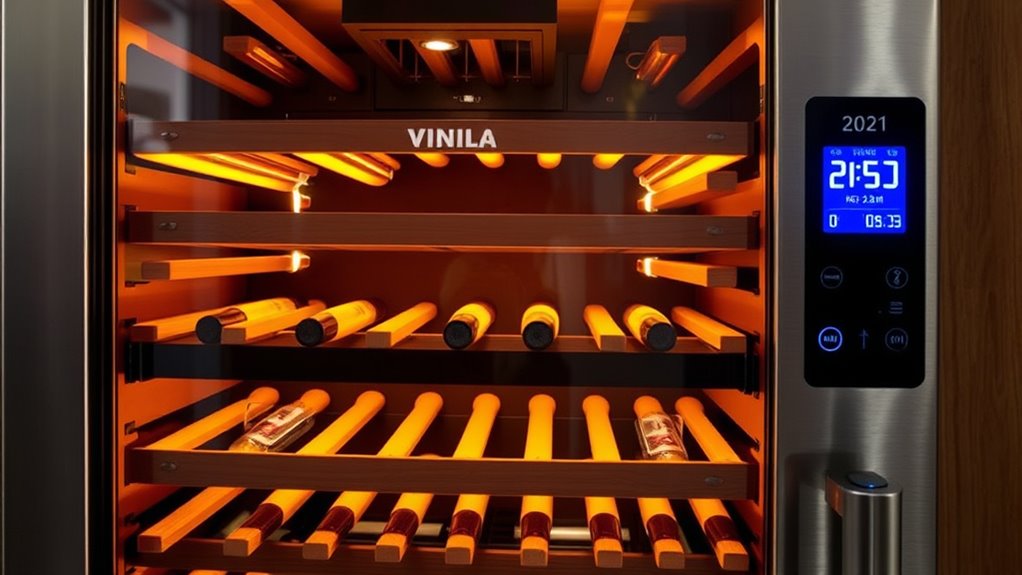
Modern wine coolers incorporate a range of innovative features and advanced technology to guarantee ideal storage conditions and convenience. You’ll find smart cooling systems that automatically adjust temperature and humidity for optimal preservation. App control lets you monitor and manage your cooler remotely, giving you flexibility and peace of mind. Here are some standout features:
Modern wine coolers feature smart technology, app control, UV-protected glass, and customizable zones for optimal wine preservation.
- Smart cooling ensures your wine stays at perfect conditions without manual adjustments.
- Touchscreen interfaces provide easy access to settings and display real-time status.
- UV-protected glass doors keep harmful light away from your collection.
- Customizable zones allow precise temperature control for different wine types.
- Modern wine coolers can also incorporate Honda Tuning features such as enhanced cooling efficiency and smart system integration to optimize performance and energy use.
These innovations help you preserve your collection effortlessly while adding a touch of modern elegance.
Maintaining and Caring for Your Wine Storage Investment
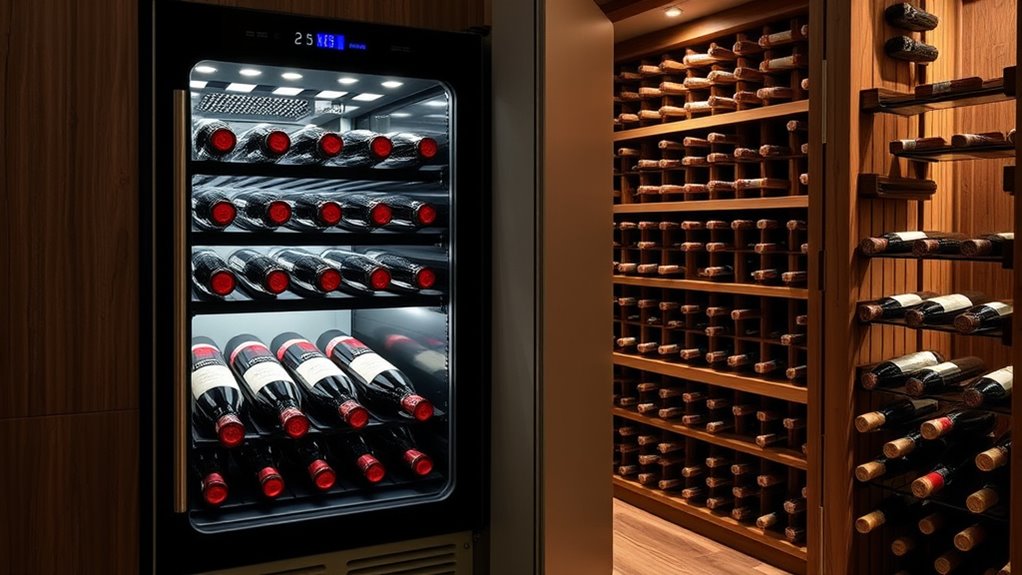
Proper maintenance is essential to guarantee your wine storage investment remains in top condition for years to come. Consistently monitoring temperature and humidity levels helps assure optimal wine aging and bottle preservation. Keep your wine fridge or cellar clean and free of dust, and check seals regularly to prevent air leaks that could damage your collection. Handle bottles carefully, especially when moving or rearranging, to avoid disturbing sediment or compromising corks. Avoid frequent temperature fluctuations, which can negatively impact wine aging and potentially spoil your collection. If you notice any issues, address them promptly to prevent long-term damage. By staying attentive and performing routine upkeep, you protect your investment and ensure your wines continue to mature beautifully over time.
Enhancing Your Home Décor With Stylish Wine Storage Solutions
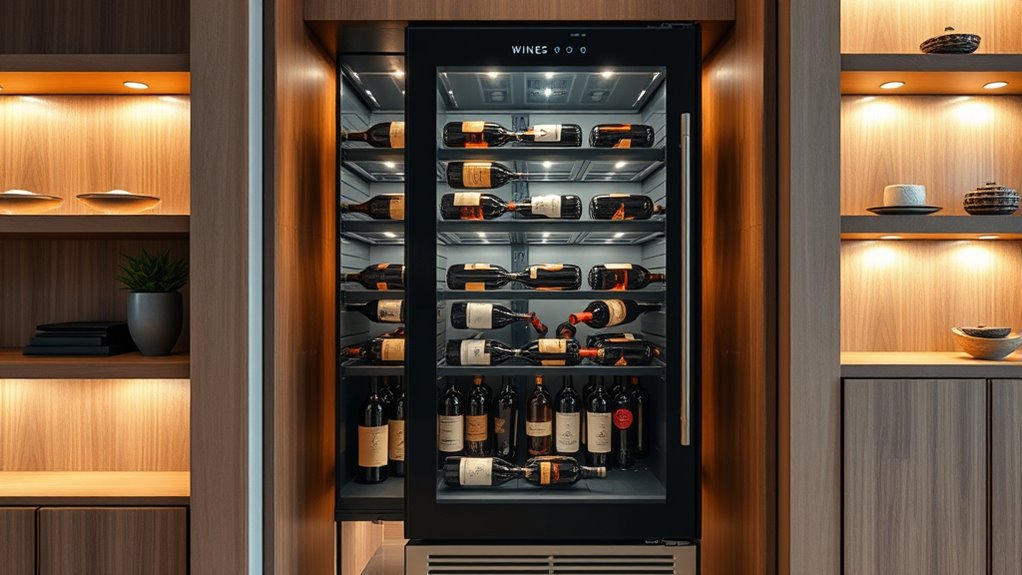
Since wine storage can be both functional and stylish, choosing the right solutions allows you to enhance your home décor while keeping your collection accessible. Here are four ways to elevate your space:
Stylish wine storage enhances décor and keeps your collection accessible.
- Built-in Wine Racks: Integrate them into your kitchen or bar area for a seamless look, perfect for wine tasting prep.
- Glass-Front Cabinets: Showcase your collection and create an eye-catching display that complements your décor.
- Vintage Wine Cabinets: Add character with antique or modern designs that serve as statement pieces.
- Convertible Storage: Combine wine fridges with open shelving for easy access during wine pairing or tasting events.
These stylish options not only enhance aesthetics but also make wine tasting more enjoyable by keeping bottles within reach.
Frequently Asked Questions
How Does Wine Storage Impact the Aging Process?
You should know that proper wine storage greatly impacts bottle maturity and aging. When you keep wine at the right storage temperature, it slows down chemical reactions, allowing your wine to develop complex flavors over time. If you expose it to fluctuating or high temperatures, you risk premature aging or spoilage. Consistent, ideal storage conditions help guarantee your wine matures beautifully, maximizing its potential and enjoyment when you uncork it.
Are There Eco-Friendly Wine Cooling Options Available?
You’ll find eco-friendly cooling options that prioritize sustainability, like energy-efficient wine coolers and sustainable refrigeration systems. These models use less power, reduce your carbon footprint, and often incorporate environmentally friendly materials. By choosing these options, you support eco-conscious practices while properly chilling your wine collection. Sustainable refrigeration not only helps the environment but also guarantees your wines are stored at ideal temperatures, preserving their quality over time.
Can Wine Fridges Be Integrated Into Existing Home Designs?
You can absolutely integrate wine fridges into your home design, transforming your space into a wine lover’s paradise. Picture custom cabinetry seamlessly housing your wine fridge, making it look like a work of art rather than an appliance. With clever space integration, it becomes the centerpiece of your room, blending effortlessly with your existing decor. No matter your style, you can create a sleek, functional wine storage area that feels like part of your home’s natural flow.
What Are Common Mistakes to Avoid in Wine Storage?
When storing wine, you should avoid common mistakes like exposing bottles to temperature fluctuations and improper humidity. Temperature swings can spoil your wine, so keep it steady between 45-65°F. Additionally, guarantee humidity stays around 60-70% to prevent corks from drying out. Don’t store wine in direct sunlight or near heat sources. Properly managing temperature and humidity helps your collection age gracefully and remain flavorful.
How Long Can Wine Be Stored in a Wine Fridge or Cellar?
You can store wine in a wine fridge or cellar for several years if you maintain temperature stability and humidity control. Ideally, keep the temperature between 45-65°F and humidity around 60-70%, which prevents spoilage and cork deterioration. Regularly monitor these conditions to guarantee your wine ages gracefully. Proper storage conditions help preserve flavor, aroma, and quality, making your collection enjoyable for years to come.
Conclusion
Choosing the right wine fridge or cellar is like tending a delicate garden—you nurture it with care, patience, and the right environment. When you select a storage solution that fits your space and style, you’re not just preserving wine—you’re cultivating a legacy of elegance and flavor. With proper maintenance and modern features, your collection will flourish, turning your home into a sanctuary where every bottle is a treasured bloom waiting to unfold.


